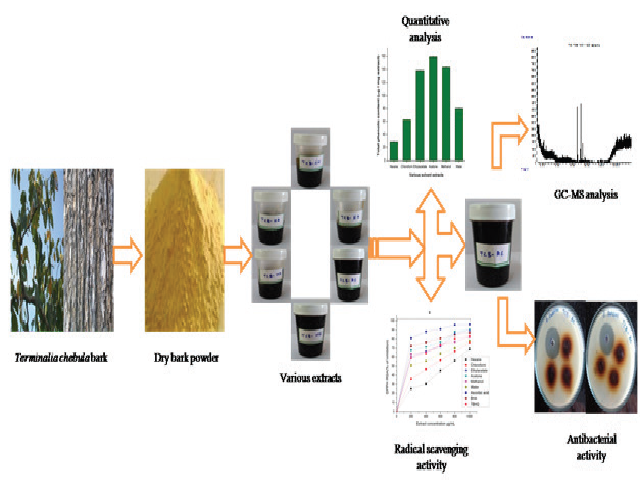Antioxidant, Antibacterial Activities and Identification of Bioactive Compounds from Terminalia chebula Bark Extracts
DOI:
https://doi.org/10.5530/fra.2017.1.7Keywords:
Antibacterial, Antioxidants, GC-MS analysis, Phytochemicals, Terminalia chebulaAbstract
Background: Free radical induces numerous diseases by damaging biomolecules such as lipids, proteins, RNA and DNA. Several scientists reported that numerous plants and plant extracts have potent antioxidant activities to scavenge free radicals. The present study was aimed to screen phytoconstituents, in vitro antioxidant and antibacterial potential in various solvent extracts of Terminalia chebula bark. Methods: Phytochemical analysis, estimation of various metabolites, in vitro antioxidant and antibacterial activity were done by adopting standard protocols. Selected bioactive (acetone) extract of T. chebula was analyzed for their phytochemical profile by GC-MS analysis. Results: The results of preliminary phytochemical screening analysis revealed that presence of various phytochemicals like, alkaloids, flavonoids, glycosides, terpenoids, phenolics, saponins and carbohydrates in most of the tested extracts. Acetone extract possess significant high quantity of both primary and secondary metabolites when compared with other extracts. Remarkable free radicals scavenging potential was observed in acetone extract with lowest IC50 values on all tested radicals namely, DPPH. (IC50=144.77 μg/ml), NO. (IC50=149.46 μg/ml), .OH (IC50=121.18 μg/ml), O2 .- (IC50=159.41 μg/ml), Reducing power (IC50=35.85 μg/ml), Fe2+ ion chelating (IC50=137.56 μg/ml) and TBARS (IC50=201.96 μg/ml). Acetone extract expressed significant high antibacterial activity against S. typhi (15 mm). The result of GC-MS analysis of acetone extract shows the presence of 32 major bioactive compounds, including various phenolic, sesquiterpene, flavonoid, triazine and gibberellin compounds. Conclusion: The present study suggested that T. chebula bark extract serves as a good source of phytochemicals, natural antioxidant and antibacterial agent.
Downloads
Metrics





